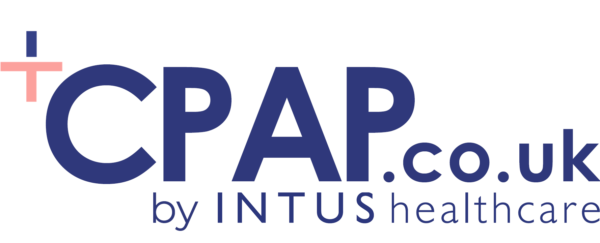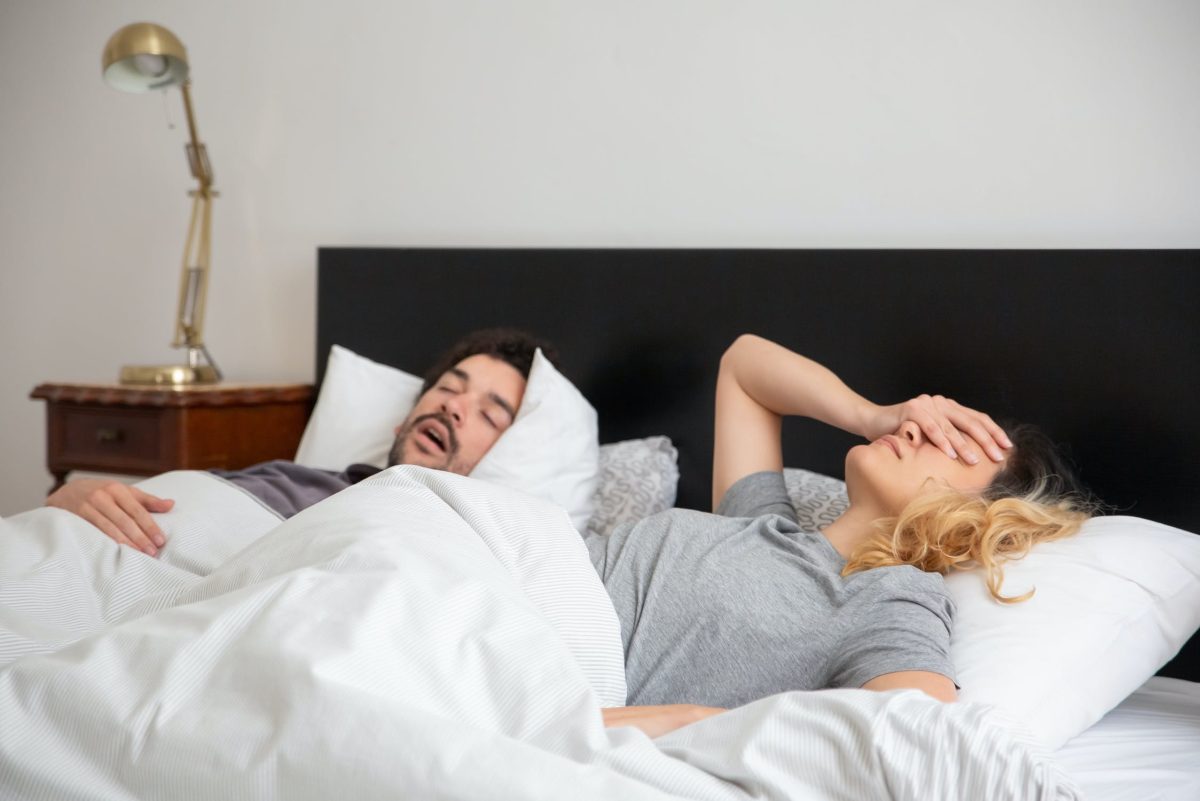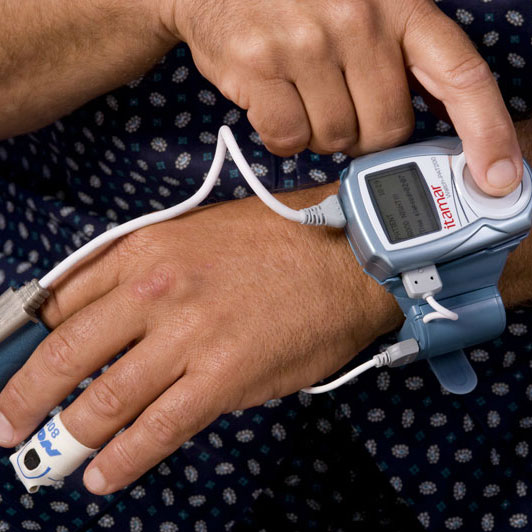Last updated on October 24th, 2023 at 10:16 am
Are you losing sleep because of your partner’s snoring? Maybe you’re wondering why your partner stops breathing in their sleep. Chronic snoring and breathing pauses could mean your partner has Sleep Apnoea.
Here is how to know if your partner has Sleep Apnoea and what to do next:
What is Sleep Apnoea?
Obstructive Sleep Apnoea (OSA) is a common sleep condition. OSA is when the upper airways narrow or close during sleep, and the throat muscles relax too much. This prevents enough air from getting to the lungs, which is called a Hypopnoea event.
Or it closes completely, stopping air from getting to the lungs, causing breathing pauses (Apnoea events) – sometimes, people stop breathing in sleep more than 30 times an hour per night (severe Sleep Apnoea).
During these breathing pauses, the diaphragm and chest muscles work harder than normal to open the airways. Forcing the person to wake up choking or gasping.
There are different severities of Sleep Apnoea, positional, mild, moderate and severe. OSA severity is calculated by the apnoea-hypopnea index (AHI), which indicates how many breathing pauses happen per hour each night. Moderate to severe Sleep Apnoea affects one in 15 adults. The British Lung Foundation found up to 85% of people with OSA are undiagnosed and untreated.
Sleep Apnoea Symptoms
Sleep Apnoea symptoms in men and women are the same; it is estimated that 20% of women have moderate Sleep Apnoea.
A primary warning sign of Sleep Apnoea is snoring, and there are ways to combat snoring.
Sleep Apnoea Warning Signs
Here are some different symptoms and warning signs of Sleep Apnoea you might find in your partner:
- Choking during sleep – Choking and gasping for air at night is a strong indicator of OSA. The airway blockages cause people to stop breathing for a moment. Resulting in waking up choking on saliva or spit.
- Daytime sleepiness – You may find your partner is constantly tired and exhausted. Consistently waking up during sleep because of breathing pauses (Apnoea events) means they are not sleeping enough.
- Brain fog – When we sleep, our bodies go through a REM cycle; when Sleep Apnoea interrupts this, it causes a chemical imbalance—impacting the brain, causing insufficient concentration, memory loss and brain fog.
- Morning headaches – It is not yet known why Sleep Apnoea headaches occur. However, researchers believe 18% of OSA patients have Sleep Apnoea headaches.
- Waking with a dry mouth – If your partner snores throughout the night, breathing through the mouth can cause a dry mouth/throat.
- Nocturia – People do not usually connect this to Sleep Apnoea. This is when someone wakes up to urinate frequently. They do this because it is a physiological reaction in their body when they stop breathing, causing them to urinate.
- Mood – You may find your partner’s mood has changed, putting a strain on you both. Sleep Apnoea can affect mental health, so finding treatment will significantly help.
You can also take a look at the Epworth Sleepiness Scale; the scale lets you know the risk of having Sleep Apnoea.
What does Sleep Apnoea sound like?
Most people discover they have OSA because someone else hears how they breathe while they sleep. You might now be wondering how to know what Sleep Apnoea sounds like.
People who struggle with OSA have laboured breathing (snoring, gasping, choking, snorts) caused by the strain on their airways.
Sleep Apnoea can be loud; you may also find your partner has deep, shallow breaths and periods of silence.
Dangers of OSA
People often ask, can you die from Sleep Apnoea?
Untreated Obstructive Sleep Apnoea can severely impact your and your partner’s quality of life. Untreated OSA can cause high blood pressure, heart disease, stroke, atrial fibrillation and type 2 diabetes.
That is why it is essential to find out if you or your partner has Sleep Apnoea.
Identifying Sleep Apnoea: Take an In-Home Sleep Test
If your partner is experiencing some or all of these symptoms, they could have Sleep Apnoea.
Contact your GP. They may refer your significant other to a sleep clinic to be tested via a sleep study.
At-Home Sleep Apnoea Test
Can you tell if your partner has Sleep Apnoea?
Yes, a quick and easy way to diagnose OSA is to take an In-Home Sleep Test.
A sleep test device monitors snoring intensity, blood oxygen levels, body position, heart rate, body movements, and Peripheral Arterial Tone (PAT).
Once an In-Home Sleep Test is completed, an experienced NHS professional (with a minimum of five years of training) will analyse the data. A detailed sleep report is produced based on the results, confirming OSA or not.
The results of your sleep test will only be sent to you. If you’re concerned about driving, please note we do not send your results to the DVLA.
Taking an In-Home Sleep Test will help you and your partner know what next steps to take.
The sleep test can help rule out Sleep Apnoea, putting you a step closer to finding out what sleep disorder your partner has.
What should you do if your partner has Sleep Apnoea?
Sleep Apnoea can’t be cured, but the symptoms can be reduced.
The severity of someone’s OSA will influence the required treatment:
- Continuous Positive Airway Pressure (CPAP) – CPAP therapy is the most popular and widely used Sleep Apnoea treatment. A CPAP device provides air pressure through a CPAP mask to keep the airways open. The positive airway pressure stops the airways from closing, stopping the breathing pauses (Apnoeas).
- Mandibular Advancement Device (MAD) – Suitable for those with mild or moderate Sleep Apnoea. The device is a good short-term treatment if used when on a flight or away from mains power. It is a mouth guard appliance that pulls your lower jaw and tongue forward, creating more space at the back of the throat, reducing and sometimes preventing Apnoeas and snoring from happening.
- Somnibel Positional Sleep Therapy Trainer – The device is for those with positional and mild Sleep Apnoea. This small device sits on the forehead, vibrating when the user sleeps upwards, encouraging them to turn onto their side—stopping Apnoea’s occurring.
Can I test myself for Sleep Apnoea?
If you think you have Sleep Apnoea and are wondering how to know if you have Sleep Apnoea, take a sleep test.
If you need further information, look at our blog or contact us.



